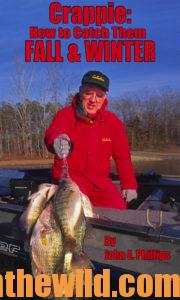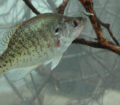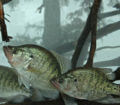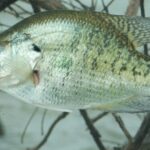Editor’s Note: Tracy Macintosh of Louisiana is a crappie fisherman, who lived and fished for many years in northwest Tennessee. I mean a real crappie fisherman, who goes crappie fishing regardless of the weather, the time of year, the water conditions and whether the crappie are in the mood or not to bite. He gives no excuse for why he can’t go or won’t go, and he believes that every day he’s on the water, he’s either going to catch crappie or learn to catch crappie. According to Macintosh, “Just because the weather’s cold, and a lake may be iced-over, we can still catch crappie in shallow-water lakes and in deep-water lakes.” Macintosh will tell us how.
Shallow-Water Lakes:
Question: Tracy, often northwest Tennessee has ice storms. Do you go fishing then?
Macintosh: Yes, I do, and I catch crappie.
Question: Tell me why.
Macintosh: When I go out on the lake during the week of an ice storm, a good portion of the lake still will be frozen. I have to break the ice with my boat to find an open water hole that the wind is blowing into so that it doesn’t freeze.
Question: How do you do crappie fishing in an iced-over lake?
Macintosh: Generally the crappie will weigh from 3/4-pound to 1-1/2-pounds each.
Question: Tracy, how do you catch fish in those ice-water conditions?
 Macintosh: I troll through the underwater lily pad stems in about 6 feet of water. I’ll move really slow with a 12-foot B ‘n’ M (www.bnmpoles.com) trolling pole. I use 8-pound-test P-Line (www.p-line.com) and Southern Pro jigs (www.southernpro.com). The blue-and-white jigs are the best colors to use on Reelfoot Lake at that time. I also fish with medium-sized live minnows as well. I won’t have any lead on the line, because I just want the jigs to move really slowly and more or less glide through the water. Reelfoot Lake crappie are in really-shallow water. When this region has an ice storm and really-bad weather, these crappie become very sluggish. The deepest part of Reelfoot is only about 20-feet deep. Even during the coldest part of the winter, we can still catch crappie from about 1/2-foot deep to 16- or 18-feet deep. If there’s not ice on the water, I usually catch crappie here on Reelfoot at 1-1/2- to 4-feet deep, and I’ll still be trolling through that shallow water. Reelfoot is a trolling lake all year long. The lake has a lot of underwater stumps that you can’t see, and there is plenty of cover in that 6- to 8-foot-deep water. Numbers of cypress tree stumps are there where the trees were cut off many years ago. You can cover more water by spider rigging than you can hand-poling.
Macintosh: I troll through the underwater lily pad stems in about 6 feet of water. I’ll move really slow with a 12-foot B ‘n’ M (www.bnmpoles.com) trolling pole. I use 8-pound-test P-Line (www.p-line.com) and Southern Pro jigs (www.southernpro.com). The blue-and-white jigs are the best colors to use on Reelfoot Lake at that time. I also fish with medium-sized live minnows as well. I won’t have any lead on the line, because I just want the jigs to move really slowly and more or less glide through the water. Reelfoot Lake crappie are in really-shallow water. When this region has an ice storm and really-bad weather, these crappie become very sluggish. The deepest part of Reelfoot is only about 20-feet deep. Even during the coldest part of the winter, we can still catch crappie from about 1/2-foot deep to 16- or 18-feet deep. If there’s not ice on the water, I usually catch crappie here on Reelfoot at 1-1/2- to 4-feet deep, and I’ll still be trolling through that shallow water. Reelfoot is a trolling lake all year long. The lake has a lot of underwater stumps that you can’t see, and there is plenty of cover in that 6- to 8-foot-deep water. Numbers of cypress tree stumps are there where the trees were cut off many years ago. You can cover more water by spider rigging than you can hand-poling.
Question: Tracy, why do you like to crappie fish in February?
Macintosh: There are very-few other crappie fishermen on the lake this month, and you can catch some really nice-sized crappie at this time of year before the spawn.
Deep-Water Lakes:
 Question: Tracy, where will you go to find crappie on deep-water lakes at this time of the year?
Question: Tracy, where will you go to find crappie on deep-water lakes at this time of the year?
Macintosh: They’ll be holding on the deep ledges. Kentucky Lake is a classic example. I’ll be fishing deep-water ledges coming off the main river channel, and I’ll be looking for drop-offs that go from 12-feet to 20-feet deep. I expect to see the crappie in 12-16 feet of water. I’ve put some stake beds and brush piles in that water depth, and I also know where some natural cover is on drop-offs that I can fish.
Question: How are you catching those crappie in that deep water?
Macintosh: I use two jig poles in one hand. I like the 10-feet length. I use an automatic reel on the backs of my jig poles because I can pull line out of it really fast. Too, I’ve learned that I can pull the line off this reel the length of my arm, and that’s equal to about 2 feet of depth. If I measure my line to the end of my pole, then when I put my jig in the water with the tip just above the water, I know my jig’s at 10 feet. If I pull from the reel a length of line equal to my arm, I know that my jig will go down to 12 feet. I’ve been using this reel for so long that I trust it as much as a depth finder.
Question: What sizes, colors and kinds of jigs are you using in that deep water?
Macintosh: I’m fishing a 1/16-ounce jig head in that deep water. I’ll be fishing red-and-chartreuse, as well as white-and-chartreuse Southern Pro tube jigs. To get my jig down quickly, I put a No. 6 split shot about a foot up the line from the jig. I let the crappie tell me how they want to take the jig. Sometimes I just get the jig down to the depth where the fish are holding and dead-stick it (hold it still and try not to move it). If the crappie don’t take it with that type of presentation, I’ll hop it up about a foot and let it fall back and hold it steady. You have to try various techniques to find out just how the crappie want to take the jig. Most of the time a crappie will take the jig quicker if it’s sitting still.
 Question: When a crappie takes a jig, the fish usually hits the jig hard. Why do you like hand-poling in cold weather instead of trolling?
Question: When a crappie takes a jig, the fish usually hits the jig hard. Why do you like hand-poling in cold weather instead of trolling?
Macintosh: I’ve found that getting a bite when I’m trolling this deep during the winter months is often hard. Also, the crappie seem to hold in tighter groups on structure at this time of the year. I may catch five to eight crappie off one brush pile or stake bed, when I’m hand-poling. Also, I can feel the fish take the bait much better when I’m hand-poling.
Question: With a pole in each hand, how do you land the fish?
Macintosh: If I catch two fish at one time, which often happens, I’ll try and determine by the way the fish bites, which one of the fish is the biggest. Once I’ve got that information, I’ll put the other pole in a rod holder, reel up the big fish and then land the other fish.
Question: How long does catching your limit of crappie on Kentucky Lake in February usually take?
Macintosh: I can usually get a limit of 30 fish in three hours of hand-poling.

 For more tips and information on catching crappie, check out John E. Phillips’ Kindle and print books “Crappie: How to Catch Them Fall and Winter” and “Crappie: How to Catch Them Spring and Summer,” or go to http://www.amazon.com/John-E.-Phillips/e/B001HP7K6O to see all of John’s books. To receive and download for free “The Crappie Catchers’ Cookbook,” by John and Denise Phillips, go to https://www.dropbox.com/sh/1tvp5nmxp8jycjf/AAAiOTM6vHolzGV44kO2oEnKa?dl=0.
For more tips and information on catching crappie, check out John E. Phillips’ Kindle and print books “Crappie: How to Catch Them Fall and Winter” and “Crappie: How to Catch Them Spring and Summer,” or go to http://www.amazon.com/John-E.-Phillips/e/B001HP7K6O to see all of John’s books. To receive and download for free “The Crappie Catchers’ Cookbook,” by John and Denise Phillips, go to https://www.dropbox.com/sh/1tvp5nmxp8jycjf/AAAiOTM6vHolzGV44kO2oEnKa?dl=0.










